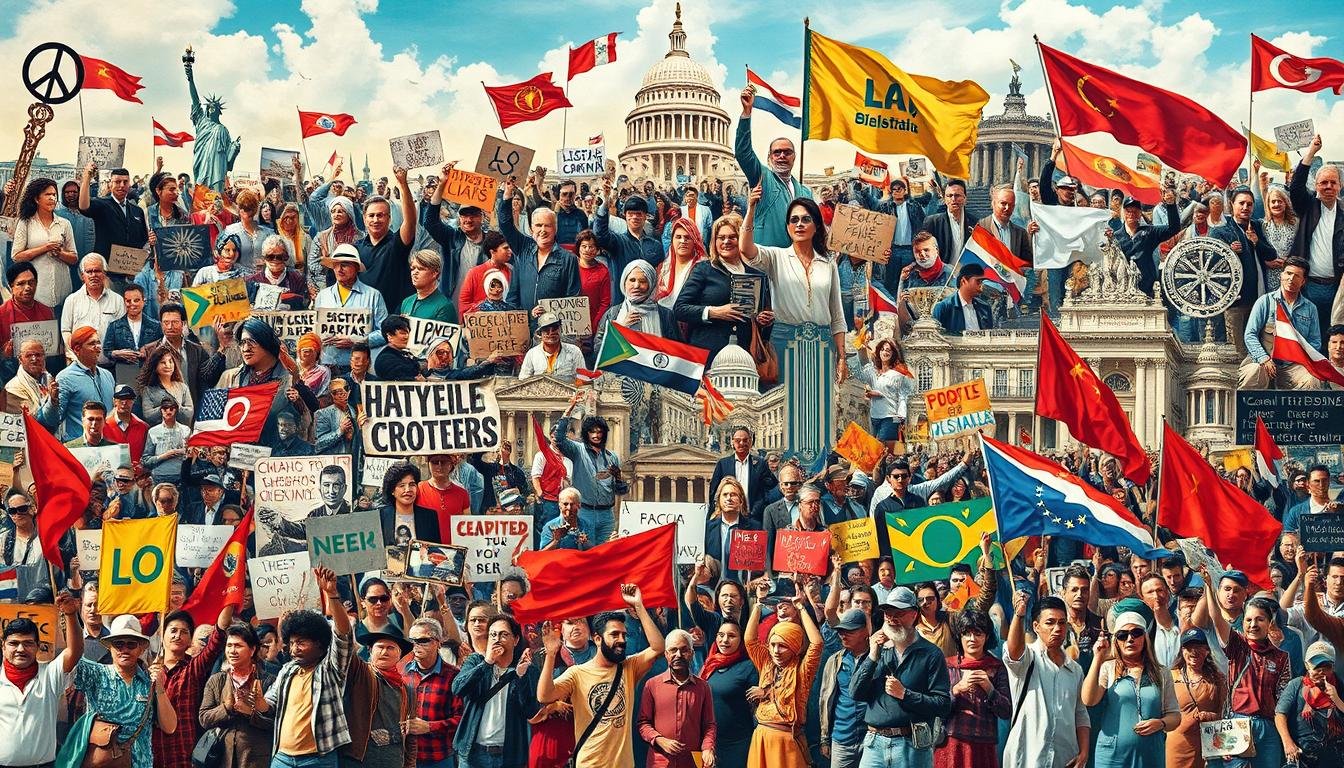The Sociology of Social Movements: Case Studies
Ever thought about how a small spark can start a big social change? The study of social movements shows us this amazing process. By looking at specific cases, we learn about the forces that shape our world.
Social movement theories help us understand how groups come together to push for change or resist it. These theories let us see how civil resistance affects society. Through detailed studies, we see how these ideas play out in real life, giving us a deeper understanding.
Case studies are powerful because they mix personal research with group talks. This method helps us learn a lot about how social movements work and what they achieve. By focusing on certain events, we get a clearer picture of how social change happens.
Recent events show how vital this field is. For instance, over 30 states now allow same-sex marriage, thanks to LGBTQ+ rights movements. Social media has boosted movements like “Me Too” and Black Lives Matter, showing how protest has changed with technology.
Key Takeaways
- Case studies provide in-depth analysis of specific social movements
- Social movement theories help explain collective behavior
- Protest movements can lead to significant social change
- Civil resistance takes various forms across different contexts
- Understanding social movements is crucial for comprehending societal dynamics
Introduction to Social Movement Theory
Social movement theory is a big part of political sociology. It looks at how grassroots activism leads to social change. Over time, this field has grown, giving us insights into how groups work together to change society.
Defining Social Movements
Social movements are ongoing efforts for social change. They can be big or small, with a few hundred to millions of people. What makes them stand out is their shared goals and how they work together.
- Collective efforts with shared values
- Mix of organization and spontaneity
- Long-lasting, often spanning years
- Informal structure with committed members
Historical Context of Social Movement Studies
The study of social movements goes way back in American history. It started with the abolitionists and women’s suffrage. Today, we see movements like civil rights and environmental activism carrying on this legacy.
Each era brings new challenges and ways for people to act together.
Key Theoretical Approaches
There are different ways scholars study social movements:
- Resource Mobilization Theory: Looks at how movements get and use resources
- Political Process Theory: Studies the political side of movements
- Framing Theory: Examines how movements share their message
These theories help us understand how movements start, grow, and reach their goals. They give us tools to see how social change happens in our complex world.
The Role of Case Studies in Social Movement Research
Case studies are key to understanding social movements. They give us a close look at how groups work together. This helps researchers learn about the strategies and results of these efforts. Historical studies have been especially important in showing how movements change over time.
In 1973, sociologists really started to focus on social movements. This led to more books and articles about them. The 1960s were a big turning point, making researchers want to learn more about how social change happens.
Case studies help researchers look into:
- Movement strategies
- Organizational structures
- Interactions between activists and opponents
- Broader social contexts
By looking at different case studies, researchers can spot common patterns. This helps them understand what makes a movement succeed or fail.
“Successful movements are typically initiated by dedicated activists who gain leverage to mobilize broader support.” – Social Movement Research Findings
Studies show that certain things help movements do well:
- Political opportunities
- Mobilizing structures
- Effective messaging
These elements together create the right conditions for change, as seen in many historical examples.
Collective Action Theory and Social Movements
Collective action theory has deeply influenced how we study protest movements and group behavior. It looks at how people unite to reach common goals, even with obstacles.
Olson’s Logic of Collective Action
Mancur Olson’s ideas on the free-rider problem changed how we see social movements. He said that people might not join in if they can get benefits without helping out. This idea helps explain why some protests lose steam.
Resource Mobilization Perspective
The resource mobilization theory looks at how social movements get and use resources. It shows the strategic side of group actions. Movements with strong resource networks do better, with about 4 out of 10 seeing success.
Political Opportunity Structures
Political situations affect how movements act and succeed. During the COVID-19 pandemic, almost 5,000 protests happened in 158 countries. This shows how politics can trigger group action. Studies say things like group conflict and shared identity boost protest participation.
| Factor | Correlation (r) |
|---|---|
| Positive attitudes towards goals | 0.44 |
| Collective efficacy | 0.36 |
| Emotions and relative deprivation | 0.35 |
| Collective identity | 0.34 |
These theories give us deep insights into social movements. They help us understand why people join groups and how protests change over time.
The Civil Rights Movement: A Landmark Case Study
The Civil Rights Movement in the United States is a key example of civil resistance and grassroots activism. From 1954 to 1968, it changed American society. It did this through non-violent protests and legal actions.
Important court decisions were key in ending segregation. The 1954 Brown v. Board of Education decision ended the “separate but equal” rule in schools. Then, Browder v. Gayle (1956) made bus segregation illegal, and Loving v. Virginia (1967) allowed interracial marriages.
Grassroots activism pushed for new laws. The movement led to key laws being passed:
- Civil Rights Act of 1964
- Voting Rights Act of 1965
- Fair Housing Act of 1968
These laws aimed to stop discrimination in voting, housing, and public places. The government also set up new agencies to protect civil rights. This included the Equal Employment Opportunity Commission in 1965.
The Civil Rights Movement’s success motivated future activists. Its methods, like sit-ins and freedom rides, still affect social movements today. The movement shows how organized grassroots activism can bring about lasting social change.
The Sociology of Social Movements: Case Studies
Case studies are key to understanding social movements. They give us deep insights into how these movements work, their strategies, and what happens as a result. “Social Movements: The Structure of Collective Action” by Paul Almeida is a great example of this approach.
Importance of Case Study Methodology
Case studies let researchers dive deep into social movements. Almeida’s book uses real-life examples of various movements. It looks at civil rights, environmental, feminist, and gay and lesbian movements. This makes it easier for students to see how social movement theories play out in the real world.
Comparative Analysis of Multiple Cases
The book offers many historical case studies for comparison. It focuses on social movements after the 1960s in American society. This lets readers see patterns and differences across different movements and settings.
Linking Theory to Empirical Evidence
Almeida’s work connects theory with real data. It uses data from the U.S. and around the world. The book talks about current movements like immigrant rights, climate justice, Women’s Marches, and Black Lives Matter.
| Book Details | Value |
|---|---|
| Price | $34.95 / £30.00 |
| Pages | 240 |
| Publication Date | March 2019 |
| ISBN | 9780520290914 |
This detailed look at social movement case studies helps us understand collective action and change in society.
Online Activism and Digital Social Movements
Digital technologies have changed how we protest and act together. Social media lets people quickly join and share information. This changes how groups plan and work together.
Look at the 2014 Ferguson protests. In just one week, over 3.6 million tweets were shared. By the end of the month, #Ferguson was used more than 8 million times. This shows how powerful online activism can be.
Online platforms help spread voices and causes around the world. The #BlackLivesMatter hashtag was tweeted nearly 30 million times from 2013 to 2018. The #LoveWins campaign also got a lot of attention on social media:
| Platform | Engagement |
|---|---|
| 97,592,956 impressions | |
| 7 million tweets | |
| 1.4 million photos |
While online activism has its benefits, it also has its downsides. Online movements can lose focus and may not keep going. Mixing digital and traditional activism often works best for lasting change.
“The strategic use of media applications, particularly utilizing public media for collaboration and engaging in multiple fora, increases the likelihood of activism’s success.”
As protests change with the digital age, knowing how online and offline activism work together is key. It’s important for activists and researchers to understand this connection.
Global Climate Change Movements: A Contemporary Case Study
Climate change is now a big issue worldwide, leading to protests and activism. These movements show us how social change happens today.
Fridays for Future and Youth Activism
The Fridays for Future movement, led by Greta Thunberg, shows how young people can make a difference. It has gotten millions of students around the world involved. Social media has been key in organizing these big protests.
Intersection of Science and Social Action
Climate change movements mix science with action. The IPCC, started in 1988, brings scientists together. Their research drives activism, pushing for policy changes based on science.
Transnational Movement Dynamics
These movements work across the globe, going beyond country lines. The UNFCCC, created in 1992, helps deal with the political side of climate change. In 2015, 195 countries came together in Paris to make binding agreements, showing the global effort.
Even with progress, there are still big challenges. Rich countries, which produce 60% of greenhouse gases, often pass on environmental issues to poorer ones. This inequality makes it hard to work together and causes policy problems worldwide.
As climate change becomes more of a global issue, these movements keep growing. They push for big changes and show how working together can tackle global problems.
Methodological Approaches in Social Movement Case Studies
Social movement theories have changed a lot, leading to new ways of studying them. Researchers now use a variety of methods to understand these complex movements. The Centre on Social Movement Studies (COSMOS) at the European University Institute in Florence is leading this change.
In April 2013, COSMOS held a workshop on different ways to collect and analyze data. They looked at fieldwork, participant observation, and other methods. They also explored new techniques like frame analysis and online research, showing how social movements use the internet.
Using more than one method to study social movements is now key. This method, called triangulation, helps check information and get deeper insights. For example, researchers might do fieldwork, surveys, and look at old records together. This mix helps solve problems like defining what to study and dealing with unclear boundaries.
When studying social movements, thinking about ethics is very important. Researchers need to work with movement participants while staying fair. As social movements change, so must the ways we study them. This ensures that case studies stay useful and give us new insights.
Source Links
- Microsoft Word – IJTLHE 2072.doc
- Microsoft Word – SOC4720.doc
- 21.2 Social Movements – Introduction to Sociology 3e | OpenStax
- Social movement | Definition, Types, Theories, & Facts
- Social Movements
- Lessons from Social Movements – Supporting a Movement for Health and Health Equity
- PII: S0191-3085(00)22007-8
- Social movements and collective behavior: an integration of meta-analysis and systematic review of social psychology studies
- Social movements and the struggle for shelter: A case study of eThekwini (Durban)
- Civil rights movement
- Goodwin: The Social Movements Reader
- Social Movements by Paul Almeida – Paper
- The digital repression of social movements, protest, and activism: A synthetic review
- Success of Digital Activism: Roles of Structures and Media Strategies
- A Guide to Activism in the Digital Age
- Sociological Perspectives on Climate Change and Society: A Review
- What is the ‘Social’ in Climate Change Research? A Case Study on Scientific Representations from Chile – Minerva
- RESEARCHING SOCIAL MOVEMENTS:METHODOLOGICAL CHOICE – ArmSocClub
- How is SI research different from existing social movement literature and relevant historical works?







